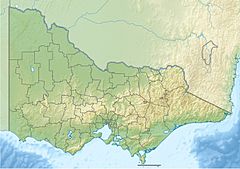Cloggs Cave facts for kids
| Location | Snowy River gorge, near Buchan, Victoria |
|---|---|
| Region | Australia |
| Coordinates | 37°31′S 148°10′E / 37.517°S 148.167°E |
| Site notes | |
| Excavation dates | 1970s |
| Archaeologists | Josephine Flood |
Cloggs Cave is a special place in Victoria, Australia. It is a limestone cave and a rockshelter. A rockshelter is like a shallow cave or an overhang on a cliff. This site is very important because it holds many clues about the ancient Aboriginal people who lived there long ago.
The cave is found on a cliff next to the Snowy River gorge. This is close to the town of Buchan, Victoria.
Contents
What is Cloggs Cave?
Cloggs Cave is a natural rock formation that has been used by people for thousands of years. It has two main parts: an outer rockshelter and an inner cave. The roof of the rockshelter is very dark. This is from many campfires that burned there over time. Inside the cave, there is a large chamber with a high ceiling, almost like a cathedral.
Where is Cloggs Cave?
Cloggs Cave is located in the beautiful Snowy River gorge. This area is in eastern Victoria, Australia. It's a place with stunning natural scenery. The cave's location on a cliff made it a good spot for people to live and find shelter.
Who Lived There?
Cloggs Cave was in the traditional lands of the Krowathunkooloong clan. They are part of the Gunaikurnai nation. These Aboriginal people lived in this area for a very long time. They used the cave as a temporary home or a place to stop during their travels.
Discovering the Past
The cave was first found by an archaeologist named Josephine Flood. She was exploring eastern Victoria in the 1970s. Her team started digging carefully in the dry floor of the rockshelter. They found many interesting things.
What Did They Find?
The excavations at Cloggs Cave showed that people were making stone tools there. These tools belonged to what is called the Australian Small Tool Tradition. The oldest tools found in the outer rockshelter were about 1,000 years old.
Further inside the cave, the discoveries were even older. It seems people first used the inner cave around 17,000 years ago! However, they stopped using the inner cave about 1,000 years ago. That's when they started using the outer rockshelter more.
Archaeologists found different kinds of tools, including those from the Australian Core Tool and Scraper Tradition. They also found bone tools, ochre (a natural earth pigment), and many animal bones. These bones tell us about the animals that lived in the area.
The cave was likely a hunting site. People would stay there for a short time to hunt animals. It wasn't a place where they lived all the time. The layers of soil in the cave were very deep. Each layer held clues from different times in history.
Why is Cloggs Cave Important?
Cloggs Cave is very important for several reasons:
- Oldest Bones: It was the first site in Australia from the Pleistocene Ice Age where archaeologists found human-made tools with bones still in their original place.
- Ancient Animals: Bones of very large, extinct animals, called megafauna, were found. These bones were between 27,500 and 24,500 years old. However, these ancient animal bones were not found with human tools. This means humans were not hunting these megafauna at Cloggs Cave.
- Long History: The cave shows that Aboriginal people have lived in south-east Australia for a very, very long time. The layers in the cave show an almost unbroken history of people living there. This history goes all the way up to the 1830s and 1860s, which was after European settlers arrived.
Cloggs Cave helps us understand the rich and long history of Aboriginal people in Australia. It shows how they lived, what tools they used, and how they interacted with their environment over thousands of years.]



